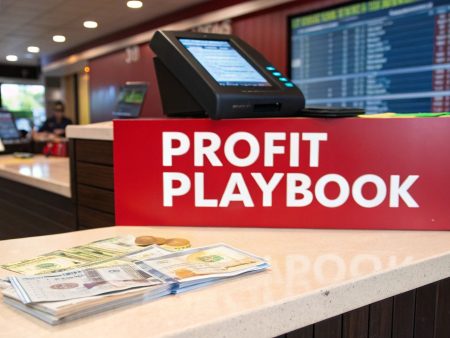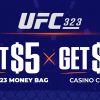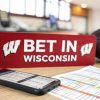When you first look at a betting line, it can seem like a jumble of numbers and symbols. But once you get the hang of it, you’ll see it’s a simple language that tells you everything you need to know about a matchup.
Reading any betting line boils down to three core numbers: the point spread (the margin of victory), the moneyline (who wins outright), and the total (the combined score).
It all starts with the plus (+) and minus (-) signs. A minus sign (-) always points to the favorite, while a plus sign (+) signals the underdog. Master this simple rule, and you’re already halfway to deciphering any betting board you’ll find at offshore sites like MyBookie or Bovada.
Decoding the Numbers on Your Bet Slip
Before you can place a smart wager on sites like Bovada or MyBookie, you have to speak the sportsbook’s language. This just means getting comfortable with the numbers, symbols, and terms on every bet slip. At first glance, it might look a little intimidating, but there’s a consistent logic behind it all, whether you’re on BetUS or BetAnything.
Think of it as a toolkit. Each part of the line gives you a different piece of the story. Oddsmakers use these lines to set the scene, showing you which team is favored and what the potential payout is for any given bet. For example, if you see a team with -150 odds, it means you need to bet $150 to win $100. On the flip side, +130 odds mean a $100 bet on the underdog would win you $130. If you’re curious about the nitty-gritty of how oddsmakers come up with these numbers, you can dig into historical odds on sites like sportsdata.io.
To give you a quick reference, here are the core components you’ll see on nearly every sportsbook, including popular offshore options like Sportsbetting.ag and Xbet.
Core Betting Line Components at a Glance
| Betting Term | What It Means | Example |
|---|---|---|
| Moneyline | A straightforward bet on which team will win the game. | New England Patriots -150 (Favorite) |
| Point Spread | A bet on the margin of victory, not just the winner. | Miami Dolphins +3.5 (Underdog must lose by less than 4 or win) |
| Total (Over/Under) | A bet on the combined score of both teams in the game. | Over/Under 48.5 points |
| American Odds | The default format at US sportsbooks, using +/- signs. | -110 (Bet $110 to win $100) or +250 (Bet $100 to win $250) |
These four elements are the building blocks of almost every wager you’ll make. Let’s break down the big three a little further.
The Essential Trio of Betting Lines
Every single bet you see on sportsbooks like BetUS, Sportsbetting.ag, or Xbet is built around three fundamental concepts. Get these down, and you’ll be placing bets with confidence on sites like Bovada or MyBookie in no time.
- Moneyline: This is the purest bet in sports. You’re just picking who you think will win the game, period. The odds simply reflect how likely each team is to win.
- Point Spread: This one is all about how much a team wins or loses by. The spread levels the playing field by giving the underdog a “head start” in points, which makes even lopsided matchups interesting to bet on.
- Totals (Over/Under): Forget who wins. With a totals bet, you’re only focused on the combined final score of both teams. Will it be over or under the number set by the sportsbook? That’s all that matters here.
Mastering the Big Three Bet Types
Alright, you’ve got the basics down. Now it’s time to get into the bread and butter of sports betting: the moneyline, the point spread, and the total (or over/under). These three are the foundation of everything. Pull up any offshore sportsbook like MyBookie, Bovada, or BetAnything, and you’ll see these options for just about every game.
Getting comfortable reading these three bet types is non-negotiable if you’re serious about this. They pop up everywhere, from a high-flying NBA game to a Sunday NFL slugfest. Each one gives you a completely different angle to attack a game and find some value.
The Moneyline Bet Explained
The moneyline is as straightforward as it gets. You’re just picking who wins the game. That’s it. The final score doesn’t matter, and the margin of victory is irrelevant. If the team you bet on gets the W, you cash your ticket.
Let’s use a classic NBA rivalry as an example, something you’d definitely see on a site like Xbet or BetUS.
- Los Angeles Lakers: -180
- Boston Celtics: +150
See the minus sign next to the Lakers? That means they’re the favorite. The -180 tells you that you need to risk $180 just to win $100.
The plus sign next to the Celtics marks them as the underdog. A $100 bet on Boston at +150 pays out $150 in profit if they pull off the upset. The risk is higher, so the reward is, too. Simple as that.
Understanding the Point Spread
The point spread is the great equalizer. It’s designed to bring two teams—even a powerhouse and a bottom-dweller—onto a level playing field for betting purposes. The favorite is “giving” points, while the underdog is “getting” points.
Picture an NFL matchup you might find on offshore betting sites like BetAnything or Sportsbetting.ag:
- Kansas City Chiefs: -7 (-110)
- Denver Broncos: +7 (-110)
Here, the Chiefs are the 7-point favorite. For a bet on them to win, they have to beat the Broncos by more than 7 points—say, 28-20. This is what’s known as “covering the spread.”
On the other side, the Broncos are the 7-point underdog. Your bet on them wins if they either win the game outright or lose by less than 7 points. A 24-20 Chiefs victory would mean a Broncos bet is a winner. If the Chiefs win by exactly 7? It’s a “push,” and everyone gets their money back.
If you really want to dig into the specifics of football wagering, our guide on how to read an NFL betting line has a ton more examples.
Pro Tip: In the NFL, always keep an eye out for “key numbers” like 3 and 7. So many games end with a margin of a field goal or a touchdown, and knowing that can make or break your bet.
Decoding Totals or Over/Under Bets
Last but not least, we have totals, which you’ll almost always hear called the over/under. With this bet, you couldn’t care less who wins. You’re simply betting on whether the total combined points scored by both teams will be over or under a line set by the sportsbook.
Let’s say you’re looking at a college basketball game on BetUS, and the total is set at 145.5 points.
- Over 145.5 (-110): You’re betting the final score adds up to 146 points or more. If the game ends 80-70 (150 total), you’ve got a winner.
- Under 145.5 (-110): You’re betting the final score adds up to 145 points or fewer. A 72-68 final (140 total) means you cash.
One thing to always remember is overtime. On most offshore sites like Sportsbetting.ag, Bovada, and MyBookie, OT points absolutely count toward the final total. This can be a miracle for over bettors and an absolute gut punch for under bettors. Always double-check the house rules before you lock in a totals bet.
Getting a Handle on Different Odds Formats
The way odds are presented can change depending on where you’re betting. A line on MyBookie might look completely different than one on an international sportsbook. Once you master the three main odds formats, you’ll be able to read any betting line on the planet and spot value in an instant.
This skill is absolutely essential for line shopping across different offshore sportsbooks like Bovada, BetUS, or BetAnything. If you can’t quickly translate the odds from one format to another, you’ll have no idea which book is giving you the best price.
American Odds
Here in the United States, American odds are the default. You’ll recognize them immediately by the plus (+) and minus (-) signs in front of the numbers. The entire system is built around the idea of a $100 bet.
- The Minus Sign (-): This always signals the favorite. It tells you how much money you need to risk to win $100. For example, odds of -150 mean you have to lay down $150 to see a $100 profit.
- The Plus Sign (+): This points to the underdog. It shows you the profit you’ll pocket from a successful $100 wager. If the odds are +130, a $100 bet nets you a clean $130 profit.
You’ll see -110 constantly, especially on point spreads and totals at offshore sportsbooks like Xbet and Bovada. That little extra is the sportsbook’s commission, often called the vig or juice.
This next chart breaks down the implied probability for a standard -110 bet versus its +110 counterpart.
As you can see, the -110 favorite has a higher implied probability of winning (52.4%) than the +110 underdog (47.6%)—which is exactly how the odds are designed to work.
Decimal and Fractional Odds
While American odds rule the US market, you’ll run into two other common formats, especially if you explore international sites or even some offshore books like Sportsbetting.ag.
Decimal Odds are king in Europe, Australia, and Canada. I find them the most straightforward—they show your total payout (your original stake plus your profit) for every $1 you bet. If you see odds of 2.50, a $100 bet will return $250 total ($150 of which is your profit). Simple.
Fractional Odds, popular in the UK and Ireland, express your potential profit relative to your stake. If you see odds of 5/2 (you’d say “five-to-two”), it means you stand to win $5 for every $2 you risk.
Odds Format Conversion Guide
This table shows how the same likelihood of an event is represented across all three formats. Getting comfortable with these conversions is a game-changer when comparing lines across sites like Bovada, BetUS, MyBookie, Sportsbetting.ag, Xbet, and BetAnything.
| American Odds | Decimal Odds | Fractional Odds | Implied Probability |
|---|---|---|---|
| -200 | 1.50 | 1/2 | 66.7% |
| -110 | 1.91 | 10/11 | 52.4% |
| +100 | 2.00 | 1/1 | 50.0% |
| +150 | 2.50 | 3/2 | 40.0% |
| +300 | 4.00 | 3/1 | 25.0% |
Being able to look at 3/2 odds and know it’s the same as +150 without blinking is a huge advantage.
Key Takeaway: No matter how they’re displayed, the payout is identical. The only thing that changes is the presentation. Getting fluent in all three gives you a massive leg up when you’re hunting for the best numbers.
For a closer look at how these odds play out in real-time for specific matchups, check out our complete guide to understanding current NFL odds. Honing these conversion skills is a fundamental step toward reading betting lines like a seasoned pro.
How to Find Real Value in the Odds
Being able to read a betting line is step one. The real art, though, is learning to spot genuine value in those numbers. This is what separates casual bettors from the sharps who win consistently. It all boils down to translating the odds you see on offshore sites like MyBookie, Bovada, or BetUS into what they really mean for a team’s chances.
This is a concept called implied probability. In plain English, it’s the percentage chance of a win that a specific betting line is suggesting. For instance, odds of -150 don’t just tell you to risk $150 to win $100; they’re hinting that the bookmaker gives the favorite a 60% shot at winning. Nailing this conversion is the first real step to finding an edge.
Calculating Implied Probability
You don’t need a math degree for this, I promise. The formulas are simple and unlock a much deeper way to read the lines.
Here’s the quick-and-dirty way to calculate implied probability from American odds:
- For favorites (negative odds):
Risk / (Risk + Win) * 100- Take -150 odds:
150 / (150 + 100) * 100 = 60%
- Take -150 odds:
- For underdogs (positive odds):
100 / (Odds + 100) * 100- Take +120 odds:
100 / (120 + 100) * 100 = 45.5%
- Take +120 odds:
Once you can do this on the fly, you’re armed and ready to hunt for value on any sportsbook, from Bovada and MyBookie to Xbet and BetAnything.
Spotting Value Bets in Real Time
Finding value is simply a game of comparing the sportsbook’s implied probability to your own analysis. If you’ve done your homework and believe a team has a better shot to win than the odds are giving them credit for, you’ve found a value bet.
Let’s walk through a real-world example. You’re browsing NFL lines on Sportsbetting.ag and see the Miami Dolphins listed at +120 against the Buffalo Bills. We just calculated that this implies a 45.5% chance to win.
But you’ve been watching both teams closely. You’ve analyzed the injury reports, recent performance, and key matchups. Your own assessment puts the Dolphins’ actual chances closer to 50%.
This is the sweet spot. When your probability is higher than the sportsbook’s implied probability, you’ve identified a wager with positive expected value (+EV). This is the absolute cornerstone of long-term, profitable sports betting.
Don’t just trust your gut, though. Historical betting data is a goldmine for interpreting lines, as it helps you see trends and market patterns that sharpen your own probability models. Digging into how lines have moved in the past can give you a serious leg up. If you’re curious how the pros do it, you can see how they use extensive sports odds data to find an edge.
By consistently finding—and betting on—these value opportunities, you start to tilt the long-term odds back in your favor.
Why Betting Lines Move and What It Tells You
Think of betting lines as living, breathing numbers. They aren’t set in stone. From the moment they’re released until kickoff, these lines shift and react to a ton of different factors. If you can learn to read why they’re moving, you’ll be miles ahead of the average bettor. It’s a skill that can help you spot value and time your wagers for the best possible price.
The simplest reason for a line to move is that too much money is coming in on one side. Offshore sportsbooks like Bovada, MyBookie, and BetUS aren’t trying to outsmart you; their main goal is to get balanced action—roughly equal money on both outcomes. When a flood of bets pours in on one team, they have to adjust the line to make the other side more appealing. It’s just smart business to reduce their risk.
Public Money and Game-Changing News
When the general public overwhelmingly bets on one side, sportsbooks take notice. Let’s say it’s a huge NFL game and 75% of the bets at MyBookie are on the Kansas City Chiefs at -6.5. The book will likely nudge that spread up to -7 or even -7.5 to encourage some action on the underdog and balance their liability.
Of course, breaking news can also send a line into a frenzy. A single piece of information can trigger an immediate and dramatic shift in the odds.
- Star Player Injuries: This is the big one. If a starting quarterback is unexpectedly ruled out, you can see a point spread swing by as many as 7 points in an instant.
- Weather Conditions: An outdoor game with a sudden forecast for high winds or a snowstorm will almost always cause the totals (Over/Under) line to drop. Scoring just gets tougher in bad weather.
- Last-Minute Lineup Changes: Even non-injury related scratches or lineup shuffles right before a game can force oddsmakers at offshore sites like Xbet and BetAnything to make quick adjustments.
The Tell-Tale Sign of Sharp Money
While public money and news are key, the most fascinating—and revealing—type of line movement is what’s known as reverse line movement. This is when the betting line moves in the opposite direction of where the majority of the bets are going.
For example, say 80% of the bets are on the Los Angeles Lakers, but the line actually moves to make the Lakers less of a favorite. That’s a massive red flag that something is up.
Reverse line movement is a strong indicator that big, respected wagers from professional bettors—the “sharps”—are hitting the other side. Sportsbooks have immense respect for sharp money and will move their lines to avoid getting torched by these pros.
Learning to spot this is like getting an insider tip on where the smart money is flowing. It’s a powerful tool for any serious bettor.
As technology has advanced, so has the precision of betting lines. Modern sportsbooks use sophisticated algorithms that process massive amounts of data and public betting trends to set and adjust their lines in real-time.
Ultimately, keeping an eye on line movement at sportsbooks such as Sportsbetting.ag and BetAnything adds a whole new layer to your analysis. It helps you understand the story behind the numbers, not just the numbers themselves. For a closer look at the people behind the odds, check out our guide on who creates NFL betting lines.
Common Questions About Reading Betting Lines
Once you start clicking around on offshore sportsbooks like MyBookie, Bovada, or Xbet, the theory hits reality. All the numbers and terms suddenly have real money attached to them, and that’s when the practical questions pop up.
Getting a handle on these common scenarios is what separates a confused beginner from a confident bettor. Let’s walk through the questions that almost everyone asks when they first get started.
What Does It Mean When a Spread Is a Pick Em or PK?
Every now and then, you’ll see a game where the point spread is listed as PK. That’s just a shorthand for “pick ’em,” and it means the oddsmakers see the two teams as dead even.
In a nutshell, there is no handicap. A PK bet is just a moneyline wager wearing a different hat. You aren’t worried about the margin of victory anymore; you’re simply picking the team you think will win the game, straight up. You’ll see this pop up in matchups that bookmakers at offshore sites like Sportsbetting.ag or BetUS figure are too close to call.
How Does the Vig or Juice Affect Betting Lines?
The “vig” (short for vigorish) or “juice” is the cut a sportsbook takes for booking your action. It’s their built-in house edge, and it’s the reason you see -110 on both sides of a spread or total instead of an even +100.
Think of it this way: to win $100, you have to risk $110. That extra $10 is the sportsbook’s fee. It might not seem like much on a single bet, but it’s the single biggest obstacle to becoming a profitable bettor over the long haul. Understanding this fee is a crucial part of reading betting lines like a pro at any offshore book like MyBookie or Bovada.
Key Insight: To beat the standard -110 juice, you have to win more than 52.4% of your bets just to break even. That small commission is the mountain every successful bettor has to climb.
Can I Bet on More Than Just the Final Score?
Absolutely. The world of sports betting goes way beyond just picking winners and losers. Most action happens in the world of “proposition bets,” better known as prop bets. These are wagers on smaller events within a game that might have nothing to do with who ultimately wins or loses.
Hop onto an offshore platform like Bovada, BetUS, or MyBookie during a big game, and you’ll find a massive menu of props. They generally fall into a few categories:
- Player Props: This is where you can bet on a specific player’s performance. For example, will a quarterback throw for over or under 2.5 touchdowns? Or will a basketball player grab more than 8.5 rebounds?
- Game Props: These bets are tied to team or game events. You could wager on which team will score first, whether the game will go to overtime, or the total number of field goals kicked.
- Novelty Props: Reserved for massive events like the Super Bowl, these are the fun, sometimes silly bets. Think of wagering on the result of the coin toss or the length of the national anthem.
Prop bets open up a ton of different ways to find an edge. If you have a good read on a specific player matchup but are unsure about the game’s final score, props are your best friend. Exploring the options on sites like BetAnything, Sportsbetting.ag, and Xbet can add a whole new layer of strategy to how you watch and wager on sports.
Ready to put your knowledge to the test? At USASportsbookList, we provide detailed reviews and comparisons of the top online sportsbooks, helping you find the perfect platform with the best odds and features for your betting style. Make your next wager an informed one by visiting https://usasportsbooklist.com.


















